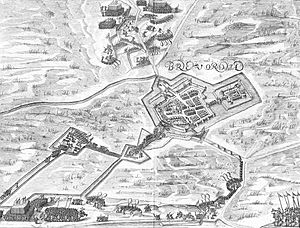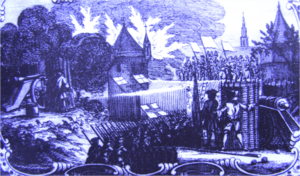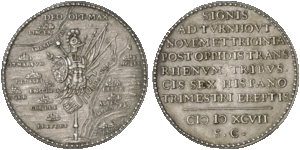Siege of Bredevoort (1597) facts for kids
Quick facts for kids Siege of Bredevoort in 1597 |
|||||||
|---|---|---|---|---|---|---|---|
| Part of the Eighty Years' War | |||||||
 Map of the siege of Bredevoort 1597 |
|||||||
|
|||||||
| Belligerents | |||||||
| Commanders and leaders | |||||||
| Strength | |||||||
| 6,000 infantry 1,200 cavalry |
200 infantry (Bredevoort) 40 cavalry (Bredevoort) |
||||||
| Casualties and losses | |||||||
| Unknown | 80 | ||||||
The Siege of Bredevoort in 1597 was an important battle. It happened during the Eighty Years' War and the Anglo-Spanish War. This siege took place in the town of Bredevoort.
Prince Maurice of Nassau led the Dutch and English forces. They attacked Bredevoort from October 1 to October 9, 1597. After nine days, Maurice's troops took control of the town. This siege was part of a larger plan. Prince Maurice was trying to capture many cities. He successfully took Turnhout, Alphen, Rijnberk, Meurs, Bredevoort, Groenlo, Goor, Enschede, Oldenzaal, Ootmarsum, and Lingen.
The Battle for Bredevoort
Bredevoort was thought to be a very strong town. It was surrounded by swamps, which made it hard for attackers to bring their cannons close enough to fire. The town was defended by only 200 soldiers. They were led by a French captain named Damien Gardot.
Prince Maurice arrived with a large army. He had 6,000 foot soldiers and 1,200 cavalry (soldiers on horseback). This included 13 companies of English troops. They were led by Horace Vere.
Maurice's Clever Plan
To get past the swamps, Prince Maurice used a new invention. He had special bridges made of cork. These bridges were light and easy to move. They had never been used in battle before. The cork bridges worked very well. They allowed Maurice's army to move their heavy cannons close to Bredevoort's walls.
The cannons fired at the walls, making a big hole. This hole meant Maurice's soldiers could rush into the town. A fierce fight began inside Bredevoort. The defenders fought hard but had to retreat to the castle.
After the Fight
Maurice's soldiers searched the town for valuable items for two days. After this, the defenders in the castle agreed to surrender. Captain Gardot and his soldiers were allowed to leave the town. They had to pay a ransom, which is a payment to be set free.
During the night, one of Maurice's soldiers accidentally started a fire. He knocked over a candle near some hay. The fire quickly spread and burned most of the town. Only about twenty houses were saved. Many citizens ran to the castle for safety. Many soldiers also fled the burning town.
Prince Maurice was very upset about the fire. However, he used it as a warning to other towns. He hoped it would make them surrender more easily when his army approached. After securing Bredevoort, Maurice's army moved on. They captured Enschede next. That city was not destroyed by fire.
Images for kids






